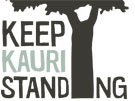Videos are filmed each day on the field trip and edited each night. Videos will be linked here during the field trip from 8-10 May 2018.
For help and more information about LEARNZ videos, go to Help with Videos in the LEARNZ Support section.
Video question sheet - Word (31k) | PDF (217k) | Google Doc to use for each video (based on SOLO Taxonomy).
Tuesday 8 May
1. Exploring Waipoua Forest
You’ve driven from Kerikeri to Waipoua Forest. Here you meet Tāne Mahuta ambassador Conrad Marsh. Conrad explains the foot cleaning process before you follow his lead and head into an area of Waipoua Forest in search of kauri.
2. Kauri - An Ancient Taonga
Tāne Mahuta ambassador Conrad Marsh recounts the creation story which helped give kauri their mana. Manaakitanga is a word Conrad uses to describe the connection and the level of care he feels towards the kauri he treats as his tupuna. I wonder what impact kauri dieback has had on this relationship.
3. The Spread of Kauri Dieback
Some big old kauri stand proud in this part of Waipoua Forest. Massive trunks and spreading crowns that would have been here for 1,000 years or more. But as you will see in this video, some trees are showing clear signs that not all is well. What are these symptoms that suggest kauri dieback is present here?
4. What Makes a Forest Healthy?
Our well-being relies on the well-being of our ecosystems. What is a balanced ecosystem and what is upsetting that balance? For kauri, our kaitiaki is needed now more than ever. That way generations from now can walk among the giant kauri of tomorrow.
Wednesday 9 May
1. Kauri Surveillance
Aerial surveillance is a tool used to manage kauri dieback. It involves flying close to the ground in a grid pattern and taking photos of areas where there are kauri. I wonder how this helps scientists.
2. Tools to Monitor Kauri
In the video you are in AH Reed Memorial Park in Whangārei. See how an app is being used for field work, where a team collects data from kauri trees and their surroundings. I wonder what sort of information is collected and how this is helpful.
3. Mātauranga Māori
Travis Ashcroft gives an overview of this Māori belief system whereby the health of kauri forests can be monitored by observing the health of other species that live there. These species are called cultural health indicators.
Thursday 10 May
1. Scientists Work to Control Kauri Dieback
There is currently no cure for kauri dieback. But that is not to say that scientists aren’t trying to help kauri fight it. In today’s first video, Travis gives you some examples of the sort of work that is going on behind the scenes, such as phosphite injections, biological control, genetic resistance, and oospore control.
2. Help Stop the Spread of Kauri Dieback
You’re at Arataki Visitor Centre in the Waitākere Ranges with Ranger Stuart Leighton. Part of Stuart’s job is to make sure people are following the guidelines around keeping kauri safe. Humans can be a difficult lot! I wonder what challenges there have been throughout this process.
3. Spread the Word to Keep Kauri Standing
In this video, Stuart Leighton will show you there is no shortage of information out there about kauri dieback. A lot of work has been done to get the right messages out to the public, and there are some good free school resources too.
4. Titirangi Pupils Passionate about Kauri
You are at Titirangi School which sits on the edge of the Waitākere Ranges. tIn this video you will hear from students about the sadness felt when Auckland Council had to cut down diseased trees on private property; ideas for protecting kauri on school grounds; and how some families joined a protest to save a 500 year-old kauri being cut down for housing development.




